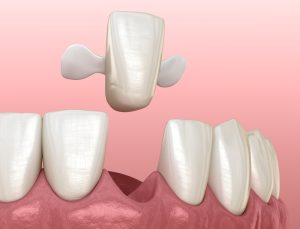Are you one of the millions of Americans missing teeth due to decay, gum disease, or an accident? If so, what are your treatment
Traditional Bridges
Traditional bridges involve creating a dental crown, or abutment, for the teeth on either side of the missing tooth with a pontic, or fake tooth, in between. This is the most common type of bridge. It can be used when you have natural teeth on both sides of the hole left by your missing tooth.
Maryland Bridges
The Maryland dental bridge is very similar to the traditional bridge. It too uses an abutment to hold in place the pontics that fill the gap left by missing teeth. The difference is that the abutment is not cemented over the natural tooth; the pontic is held in place by a framework that is bonded to the back of the tooth. Therefore, it doesn’t need to be filed down and covered by a crown.
Cantilever Bridges
The cantilever bridge differs from the traditional bridge in that the pontic is held in place by only one crown cemented to a tooth on one side of the gap. This tooth would still need to be scraped of enamel. The National Institutes of Health also warns that this process could lead to fractured teeth or a loosened crown.
Implant-Supported Bridges
Implant-supported bridges are considered the most comfortable and secure of all bridges. Instead of supporting the bridge using dental crowns, implant-supported bridges are held in place by dental implants, usually one for every missing tooth. Two surgeries are required to install the implants- one to place the implants in the jawbone and a second to place the bridge. The whole process can take up to five months.
If you are missing one or more teeth, there is hope for restoring your smile! As we have seen, a variety of dental bridges are available to replace missing teeth. Which is the best option for you? Talk to your dentist today to find out!

